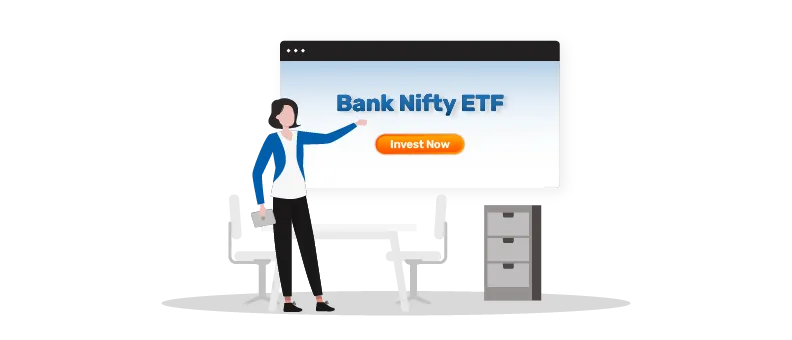How to invest in Bank Nifty Exchange Traded Funds (ETFs)


In the world of finance, investors are constantly on the lookout for opportunities to improve their returns while mitigating risks. One such way is investing in Bank Nifty Exchange Traded Funds (ETFs). In this article, we will explore the ins and outs of investing in Bank Nifty ETFs and uncover the benefits they offer to savvy investors.
- Table of contents
What is a Bank Nifty ETF?
Bank Nifty ETF is a fund that tracks the performance of the Nifty Bank Index, subject to tracking error. This index contains liquid and large capitalized banking stocks listed on the National Stock Exchange (NSE) and Bombay Stock Exchange (BSE) in India. Just like any other ETF, Bank Nifty ETF trades like a single stock on the exchange, offering investors a convenient and cost-effective way to gain exposure to the entire banking sector through a single investment. Investors can buy and sell units of the ETF on the stock exchange, providing them with a convenient way to gain exposure to the banking sector as a whole.
How to invest in Bank Nifty?
How to buy a Bank Nifty ETF? The answer is pretty simple. The follow the steps mentioned:
Open a demat account:
This acts as your investment vault, storing your ETF units. Most stockbrokers offer demat accounts, so choose one that suits your needs.
Fund your account:
Transfer funds from your bank account to your demat account. This will be your investment capital.
Choose your Bank Nifty ETF:
Make a note of the expense ratio, tracking error, and investment minimums before making your choice. You can consider opting for the Bajaj Finserv Nifty Bank ETF.
Place your order:
Once you've chosen your ETF, log in to your broker's platform and place a buy order, specifying the desired number of units.
Monitor and rebalance:
Keep an eye on your investment and the overall market. Rebalance your portfolio from time to time to maintain your desired asset allocation.
Read Also: Pros and Cons of Investing in Bank Nifty ETFs
Benefits of Bajaj Finserv Nifty Bank ETF
The Bajaj Finserv Nifty Bank ETF comes with benefits like high liquidity ensured by the Authorized Participant (AP) on the exchange and closely monitoring real-time Net Asset Value (NAV) or indicative NAV (iNAV). It offers a narrower spread on the exchange, resulting in a decreased effective spread, considering Securities Transaction Tax (STT) and brokerage.
Additional advantages include:
Diversification:
Bajaj Finserv Nifty Bank ETF provides investors with instant diversification across multiple banking stocks, reducing individual stock risk.
Cost-effectiveness:
Compared to buying individual stocks, an ETF offers lower transaction costs and requires less capital, making them accessible to a wider range of investors. Every rupee counts!
Liquidity:
Bank Nifty ETF enjoys high trading volumes, ensuring hassle-free entry and exit from the market.
Sectoral play:
If you believe in the Indian banking sector's potential, the ETF lets you capitalize on its collective growth without picking individual winners.
Convenience:
ETFs are traded like regular stocks, simplifying the investment process. No need for complex investment strategies or endless research.
Conclusion
Knowing how to invest in Nifty Bank ETF provides a convenient way for investors to participate in the growth of the banking sector. Understanding how these ETFs work and what affects their returns can help investors make smart choices. By keeping an eye on returns and staying in the know about market changes, investors can confidently handle the financial markets and enjoy the quick diversification benefits from Bank Nifty ETF.
To sum it up, the Bank Nifty ETF is a useful tool for those who want their investments to mirror the performance of the entire banking sector, subject to tracking error. It offers a simple and diverse approach to investing. So, kick off your investment journey with the Bajaj Finserv Nifty Bank ETF and pave the way for growing your wealth over the long term. Consider using a compound calculator to project how your investments can potentially grow through the power of compounding. A lumpsum mutual fund calculator can also be a useful tool to compare the potential returns of Bank Nifty ETFs with other investment options. This can help you decide if a lumpsum investment in a Bank Nifty ETF aligns with your financial goals.
FAQs:
Is Bank Nifty ETF risky?
While diversification reduces risk, the banking sector is inherently volatile. Consider your risk appetite before investing.
What is the minimum investment amount?
It varies depending on the ETF and the fund house you choose. Some allow investments as low as Rs. 500, while others may have higher minimum investment amounts.
What is the ideal investment horizon for Bank Nifty ETF?
The investment horizon depends on individual financial goals. However, since ETF is designed for long-term investors, a horizon of at least 3-5 years is recommended for optimal results.
Mutual Fund investments are subject to market risks, read all scheme related documents carefully.
This document should not be treated as endorsement of the views/opinions or as investment advice. This document should not be construed as a research report or a recommendation to buy or sell any security. This document is for information purpose only and should not be construed as a promise on minimum returns or safeguard of capital. This document alone is not sufficient and should not be used for the development or implementation of an investment strategy. The recipient should note and understand that the information provided above may not contain all the material aspects relevant for making an investment decision. Investors are advised to consult their own investment advisor before making any investment decision in light of their risk appetite, investment goals and horizon. This information is subject to change without any prior notice.